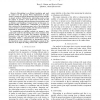Free Online Productivity Tools
i2Speak
i2Symbol
i2OCR
iTex2Img
iWeb2Print
iWeb2Shot
i2Type
iPdf2Split
iPdf2Merge
i2Bopomofo
i2Arabic
i2Style
i2Image
i2PDF
iLatex2Rtf
Sci2ools
ICRA
2010
IEEE
2010
IEEE
Sidewinding on slopes
— Sidewinding is an efficient translation gait used by snakes over flat ground. When implemented on snake robots, it retains its general effectiveness, but becomes unstable on sloped surfaces. Flattening the sidewinding motion along the surface to provide a more stable base corrects for this instability, but degrades other performance characteristics, such as efficiency and handling of rough terrain. In this paper, we identify stability conditions for a sidewinder on a slope and find a solution for the minimum aspect ratio of the sidewinding pattern needed to maintain stability. Our theoretical results are supported by experiments on snake robots. In constructing our stability analysis, we present a new, tread-based model for sidewinding that is both consistent with previous models and provides new intuition regarding the kinematics of the gait. This new interpretation of sidewinding further admits a symmetry-based model reduction that simplifies its analysis. Additionally, an i...
| Added | 26 Jan 2011 |
| Updated | 26 Jan 2011 |
| Type | Journal |
| Year | 2010 |
| Where | ICRA |
| Authors | Ross L. Hatton, Howie Choset |
Comments (0)

